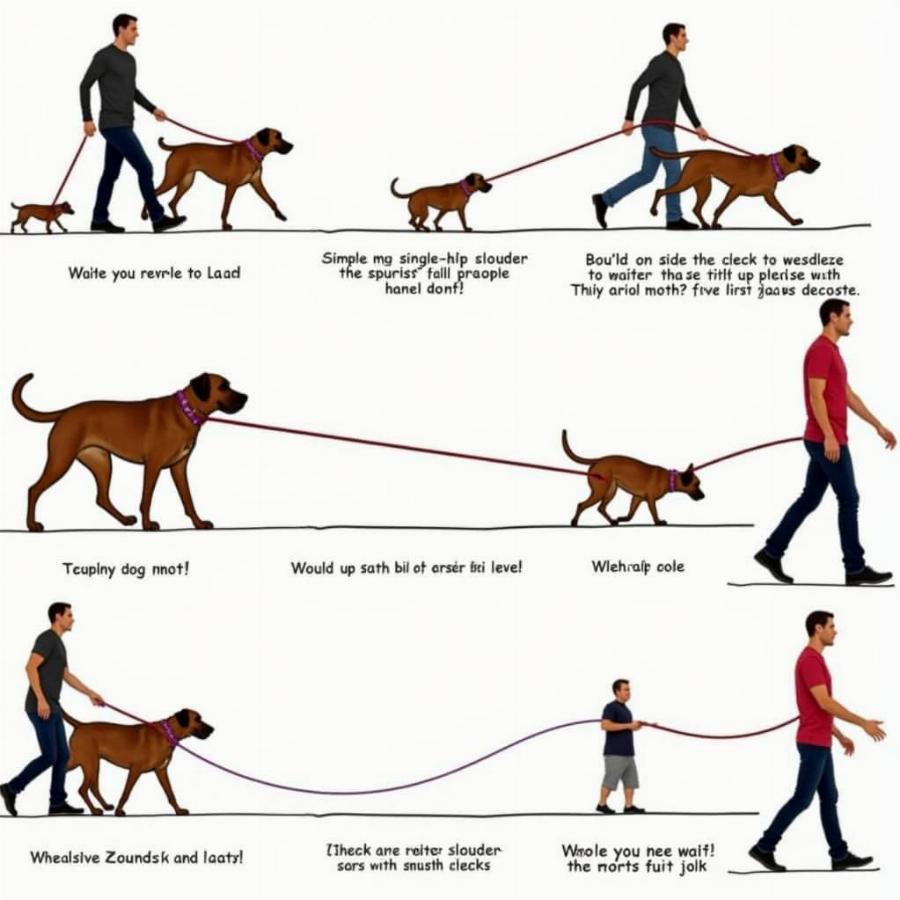Hands free leashes for dogs offer a convenient and enjoyable way to walk your furry friend, allowing you more freedom of movement while maintaining control and safety. This guide explores everything you need to know about hands free dog leashes, from choosing the right type to ensuring a safe and comfortable experience for both you and your canine companion. We’ll delve into the benefits, drawbacks, and important considerations to help you make an informed decision about incorporating a hands free leash into your daily dog walking routine.
Choosing the Right Hands Free Dog Leash
Selecting the perfect hands free dog leash depends on your individual needs and your dog’s size, temperament, and activity level. Several options are available, each with its own advantages and disadvantages.
Waist Belts
Waist belts are a popular choice, worn around your waist and connected to a leash that attaches to your dog’s collar or harness. This style allows for hands-free walking, jogging, or even hiking with your dog.
Bungee Leashes
Bungee leashes incorporate an elastic section that absorbs shock and reduces strain on both you and your dog, particularly beneficial for active dogs who tend to pull.
Dual-Handle Leashes
Dual-handle leashes provide both a standard handle and a waist belt option, offering versatility for different walking situations. This allows you to switch between hands-free and traditional leash handling as needed.
Considerations for Choosing a Hands Free Leash
- Dog Size and Strength: A larger, stronger dog will require a more durable and robust leash than a smaller, gentler breed. Consider a leash with a thicker width and stronger clips for powerful dogs.
- Activity Level: For running or hiking, a bungee leash or waist belt with shock absorption is ideal. For casual walks, a standard dual-handle leash might suffice.
- Training Level: If your dog is not well-trained in loose-leash walking, a hands free leash might exacerbate pulling. Focus on training first before transitioning to a hands-free option.
Benefits of Using a Hands Free Dog Leash
Hands free leashes provide numerous benefits for both you and your dog. They allow for greater freedom of movement, making activities like jogging, running, and hiking more comfortable. They can also be helpful for individuals with mobility issues or those who need to multitask while walking their dog.
- Increased Freedom of Movement: Enjoy greater flexibility and range of motion while walking your dog.
- Enhanced Safety: Maintain better balance and stability, reducing the risk of trips and falls.
- Convenience: Keep your hands free for other tasks, like carrying groceries or pushing a stroller.
Potential Drawbacks and Safety Precautions
While hands free leashes offer many advantages, it’s crucial to be aware of potential drawbacks and take necessary precautions. Sudden pulls from a strong dog can cause injury, and a lack of immediate control can be risky in certain situations.
- Risk of Injury from Pulling: A strong dog can pull you off balance, especially with a less robust leash.
- Reduced Control in Emergency Situations: It can be more challenging to react quickly to unexpected events.
- Potential for Entanglement: The leash can become entangled around your legs or other objects.
Training Your Dog for Hands Free Leash Walking
Training is essential for successful hands free leash walking. A well-trained dog will walk calmly beside you, minimizing pulling and maximizing enjoyment.
- Loose-Leash Walking: Teach your dog to walk politely on a standard leash before transitioning to a hands free option.
- Positive Reinforcement: Use rewards and praise to encourage desired behavior.
- Consistency: Maintain consistent training practices to reinforce good habits.
 Training a Dog for Hands-Free Leash Walking
Training a Dog for Hands-Free Leash Walking
Conclusion
Hands free dog leashes offer a convenient and enjoyable way to enhance your dog walking experience. By carefully considering your individual needs and your dog’s characteristics, selecting the appropriate leash type, and prioritizing proper training, you can enjoy the benefits of hands free walking while ensuring the safety and comfort of both you and your furry friend. Remember to always prioritize safety and be mindful of potential risks associated with using hands-free leashes.
FAQ
- Are hands free leashes suitable for all dogs? While generally safe, they are not ideal for dogs who pull excessively or are not well-trained.
- What type of hands free leash is best for running? Bungee leashes or waist belts with shock absorption are recommended.
- Can I use a hands free leash with a harness? Yes, using a harness can provide better control and distribute pressure more evenly than a collar.
- How do I prevent my dog from pulling with a hands free leash? Proper training, positive reinforcement, and consistent practice are key.
- What safety precautions should I take when using a hands free leash? Be aware of your surroundings, avoid crowded areas, and maintain a secure grip on the leash handle if needed.
- Are there any legal restrictions on using hands free dog leashes? Check local regulations, as some areas may have restrictions.
- What is the best way to clean a hands free dog leash? Most leashes can be hand-washed with mild soap and water.
Do you have other questions about dog accessories? Check out these related articles on our site:
Beaut Dogs is your ultimate resource for everything related to dog care. We offer a wealth of information on dog breeds, health, nutrition, training, and accessories. For personalized advice on hands free leashes and other dog-related topics, contact us at [email protected] (Email address). We’re here to help you provide the best possible care for your beloved canine companion. Visit Beaut Dogs today!